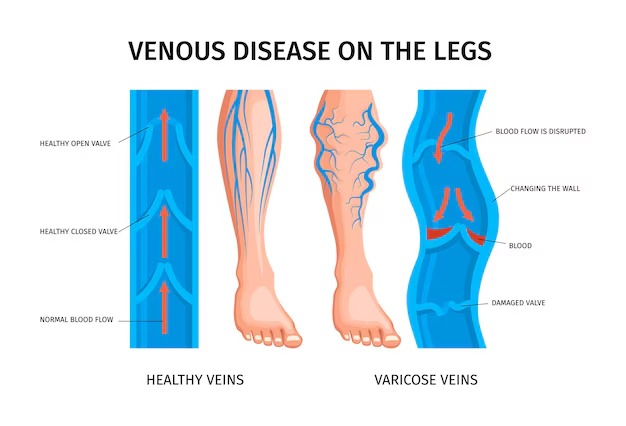A common vascular ailment that impacts people of all ages and geographical locations is varicose veins. They occur when the veins, most often in the legs, become enlarged, twisted, and overfilled with blood due to weakened or damaged valves. Although they are occasionally thought of merely a cosmetic concern, if addressed, they can cause discomfort and more significant health problems. Early treatment for Varicose veins can help prevent complications and improve overall leg health. Knowing what causes the condition, how to recognise its symptoms, and what treatments are available might help you manage it effectively.
Causes Of Varicose Veins
The leading cause of this condition is the malfunctioning of the valves inside the veins. These valves typically make sure that blood only goes back to the heart. Blood may pool in the veins when they weaken or sustain damage, making them swell and protrude noticeably.
Genetics, age, obesity, pregnancy, extended standing or sitting, and a sedentary lifestyle are some of the variables that raise the risk. Because of hormonal fluctuations, especially in women, this illness is more common in women than in men.
Recognising The Symptoms
In the early stages, the condition may only be noticeable as dark purple or blue twisted veins appearing just under the skin’s surface. However, physical symptoms, including aching legs, heaviness, swelling, and a burning or throbbing sensation, may appear as the illness worsens.
More advanced cases can lead to skin changes, itching, and even the development of ulcers near the ankles. Long durations of standing or sitting might exacerbate symptoms, which may become better when the legs are raised. Identifying these signs early allows for timely intervention, which can prevent complications.
The Role Of Gastroenterology In Vascular Health
While Gastroenterology primarily focuses on the digestive system, it is closely connected to overall circulatory health. Certain gastrointestinal disorders, such as liver disease, can increase pressure in the veins and contribute to vascular issues. Conditions like portal hypertension, for example, can lead to abnormal vein enlargement in different parts of the body.
A multidisciplinary approach that considers both vascular and gastrointestinal health can sometimes be necessary, particularly for patients with underlying health problems affecting multiple systems. This emphasises how crucial a thorough medical assessment is while managing long-term illnesses.
When Proctology Becomes Relevant?
Specialists in PROCTOLOGY deal with conditions affecting the rectum, anus, and surrounding areas, and while their focus differs from vascular medicine, there are situations where the two fields overlap. For example, chronic venous insufficiency and varicose conditions can sometimes contribute to issues such as haemorrhoids, which are swollen veins in the rectal area.
This crossover in medical expertise demonstrates how venous problems are not confined to the legs but can occur in different regions, each requiring a specific treatment approach. Awareness of this connection ensures patients receive care that addresses all aspects of their venous health.
Effective Solutions for Healthier Veins
Mild cases can be significantly reduced by altering one’s lifestyle to include regular exercise, weight control, and avoiding prolonged standing or sitting. Another good non-invasive way to increase blood flow and lessen swelling is to wear compression stockings.
For more advanced cases, medical procedures may be necessary. Common treatments include:
- Sclerotherapy: To stop the vein, a solution is injected into it.
- Endovenous Laser Treatment (EVLT): Using laser energy to seal the vein.
- Radiofrequency Ablation: Using heat to collapse the affected vein.
- Surgical Ligation and Stripping: Removing or tying off damaged veins.
These techniques offer faster recovery times than standard surgery since they are frequently less intrusive and can be done as outpatient procedures.
Prevention And Long-Term Care
Even though not every case can be avoided, forming healthy behaviours can reduce the risk and stop pre-existing problems from getting worse. Regular exercise, a balanced diet, maintaining a healthy weight, and avoiding excessive sitting or standing are all helpful. Elevating the legs when resting can also promote better circulation.
Final Thoughts
Although this condition is widespread, it should never be underestimated. Left untreated, they can lead to discomfort, skin changes, and more serious health problems. By understanding the causes, recognising symptoms early, and seeking timely medical care, individuals can manage the condition effectively and maintain better vascular health. A holistic approach that considers related fields such as gastroenterology and proctology ensures that all contributing factors are addressed, paving the way for long-term comfort and well-being.



































